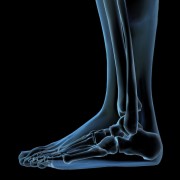Organic response to treating orthopaedic injuries
Biodegradable medical implants dissolve once tissue heals

Researchers at the Fraunhofer Institute for Manufacturing Technology and Advanced Materials in Bremen, Germany are making big strides towards creating durable, biodegradable bone implants that slowly dissolve and are eventually expelled. The research and a prototype were presented at the COMPAMED trade fair in Düsseldorf in November 2014.
The shoulder, being highly mobile and yet prone to injury, is particularly susceptible to tendon ruptures.
This injury can be repaired with orthopaedic implants made from titanium. However, the majority of implants, once having served their purpose, have to be removed or simply left in a patient’s body. The extra surgery required to remove said implants - not to mention the discomfort - can be a burden on all involved.
To counter this, researchers crafted implants from a mix of iron alloy and beta-tricalcium phosphate (TCP), a ceramic compound. The iron degrades slowly, but maintains structural integrity as the ceramic breaks down at a faster pace, while stimulating new tissue generation and ingrowth to fill the space left behind.
The whole process takes about two years.
A technique called powder injection moulding was used to fabricate the implants. This technique allows for adjustments of density and porosity, which could mean the possibility of creating customised implants that break down in a pre-programmed manner.
“It is important to determine the right amount of ceramics as a function of the powder amount. If the proportion is too high, the material will be brittle. On the other hand, the tricalcium phosphate accelerates the degradation of the implant,” Dr Philipp Imgrund, manager of the medical technology and life sciences for Fraunhofer Institute for Manufacturing Technology and Advanced Materials IFAM, said in a press release.
While it may be a while before this technology can be used in clinical applications, the team is already developing a solution to analyse degradation and ingrowth behaviour of the implants to gain a better understanding of how they would work in human bodies.
This article first appeared in the January 2015 issue of Global Health and Travel.
Further links:
Medgadget.com
Gizmodo.com
Related Articles
When should I see a doctor for hip pain?
Dr Andrew Dutton shares what to expect when seeing the doctor for hip pain
Read moreWhat if your child has joint pain?
Arthritis can significantly affect the life of young children if it is not treated early, according to Dr Cham Weng Tarng from Sunway Medical Centre
Read moreWhat causes back pain?
Dr Benjamin Tow discusses the most common causes of acute and chronic back pain
Read moreLatest Articles
Medical Care
Achieving Swift Recovery: Enhanced Recovery (ERAS) Direct Anterior Approach Total Hip Replacement
Consider total hip replacement with Alps Orthopaedic Centre's ERAS Direct Anterior Approach for faster recovery and reduced hospital stays. Learn about Dr. Jerry Chen's expertise in Singapore.
Read moreMedical Care
Enhanced Recovery (ERAS) Total Knee Replacement
Discover how Alps Orthopaedic Centre's Enhanced Recovery After Surgery (ERAS) approach transforms total knee replacement into a day surgery, offering faster recovery, less pain, and reduced hospital bills. Learn about Dr. Jerry Chen's expertise and schedule your appointment in Singapore.
Read moreMedical Care
Clinical Exercise Physiologist (CEP): The Emerging of Exercise is Medicine
How Exercising can be a Medicine
Read more